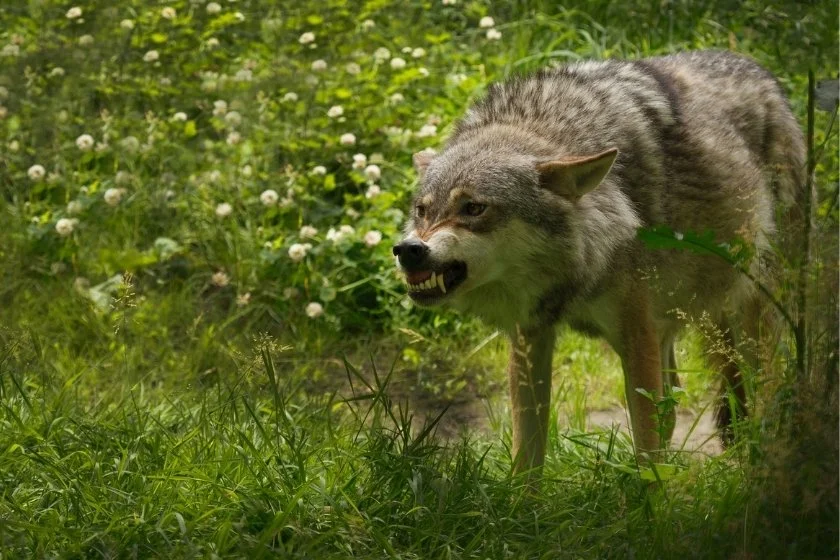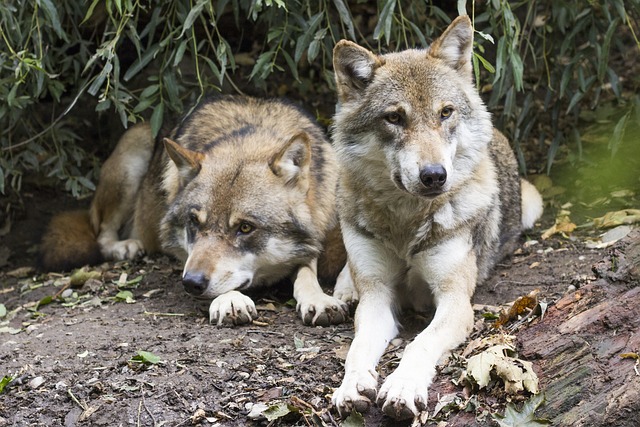Wolves are wild animals who hunt in packs and live in habitats filled with tons of trees.
Knowing this, it is easy to firmly assume that wolves are good climbers and thus take advantage of climbing trees. But is that the case? Can wolves climb trees?
Unfortunately, as agile as wolves are, they can’t climb trees. That is the reality. Though they are tenacious creatures that flourish in different habitats, trees are the one spot you’d rarely find a wolf.
Yet, you may wonder, if they can’t climb trees, does this means prey can seek refuge hiding in trees?
Or are there specific trees (such as short ones) that they may be able to climb? This article provides intriguing insights into a wolf’s ability—or otherwise—to climb.
Can Wolves Climb Trees?

A straightforward answer is no. Wolves do not possess the physical ability to climb; therefore, they cannot climb trees. Still, they can improvise.
Their powerful hind legs can help them reach lower branches, and with the help of a powerful body mass, they can make impressive jumps to get to branches that may be a bit high up.
However, wolves naturally wouldn’t wander on trees unless there’s something desirable in the tree, which could be fruits or prey.
While the inability of wolves to climb trees may seem like a curse, it’s a great balance to the natural order of things in the wild as it has helped to keep them and other land predators’ (lions, tigers, etc) populations in check by limiting the range of hunts, thereby avoiding unbalanced extinction of other animals.
How High Can Wolves Climb?
Since wolves can’t climb trees at all, the only way to know the height they can reach is by knowing how high they can jump. On average, an adult wolf can jump 12 feet, the same as 3.6 meters.
Twelve feet is pretty high if you consider it. Certainly, wolves will find it pretty easy to climb a tree with branches 11 feet from the ground.
Also, depending on their goal and how stunted and branched the tree is, they can move a little further up, say 15 feet.
However, the majority of them rather not take chances to go for heights. Wolves know that they are bad climbers.
Even if they reach a certain height, there is still the issue of descending. Most times, it is also quite difficult to gain balance on trees.
Reasons Wolves Can’t Climb Trees
Over the years, animals that can climb have evolved to do so based on necessity. However, wolves are predatory animals and have little or no need to hide from other predators as there are very few predators that hunt them.1
Hence, they have never needed to seek hidden holes and caves, or climb trees for safety.
Typical wolf preys are often land-based creatures such as deer, antelopes, rodents, or bison, and they have adapted to hunt them on land, not high up a tree.
Below is a detailed breakdown of the several anatomical features in wolves that hinder them from climbing:
Their bodies are not built to climb
As stated earlier, wolves hunt land animals as they are very good at running and are very fast. Hence, they have evolved to thrive mostly on land, and their bodies have adapted to survive on the ground.
Their body structure does not make climbing easy. Wolves have shorter hind legs than their front legs, which gives a weak sense of balance during climbing.
They also have short tails, unlike climbing animals such as monkeys and small wild cats with long tails.
The latter use their tails to serve as balance while jumping narrow supports and distribute weight while climbing over unstable branches. Wolves can’t do these.
Rather, they possess sharp teeth and claws, powerful hind legs, and muscular flexibility to hunt on land successfully.
Wolves Don’t Have retractable claws
Retractable claws aid in firm grips on the bark of trees before a quick release for a fast ascent on a tree.
However, wolves do not have opposable thumbs or retractable claws; their claws are always out, big, sharp, and primarily used for digging, ripping, and shredding.
Wolves’ paws are not suitable for climbing
Another reason wolves can’t climb trees has to do with their paws. Their paws do not support climbing, because they are digitigrades.
Hence, they fall into the categorized group of animals that walk or stand entirely on the length of their toes rather than heels as it is with climbing animals.
Their paws are flat and wide that connects to long limbs, which is more fitting for running and covering long distance within short periods than going onto heady heights.
When will wolves try to climb trees?
Despite the odds against wolves when it comes to climbing, they do not completely refrain from it. So, when do they try to climb trees?
Wolves eat a lot daily. At the very least, they require 3.7 pounds of meat per day for survival and an average of 8 pounds for growing and reproducing baby wolves.2
Yet the wild is not a readily available buffet party; hence, wolves sometimes go several days without eating. When they catch prey, they eat to make up for the starving days.
However, certain periods might prove hard for these animals to find prey. Winter is a good example.
In desperate periods like these, they do whatever it takes to find food, which may very well include attempting to climb trees if the prey is spotted, especially low-branch trees that do not require much strength and balance to climb.
How Do Wolves Catch Prey in Trees?

We have established that this wild dog species can’t climb trees, but they will likely wander around trees looking for the next meal in desperate times. How do they hunt down prey on trees despite their inability to climb one?
If it’s a low tree, wolves can try to reach for their prey with a powerful jump and bite. They are quite good at jumping to a considerable height and have a strong bite that could instantly break the neck of small prey.
Also, they could try standing on their hind legs to reach prey on trees.
However, wolves are aware of their climbing disadvantage and thus would not pick trees to hunt as their first go.
How High Can Wolves Jump?
For animals like wolves, jumping is an integral move in hunting. But how high can wolves jump?
Wolves are agile and athletic creatures. Expectedly their high level of athleticism transfers to their jumping ability. Wolves can jump anywhere between 9 to 12 feet and can also jump a distance of 30 feet.
Their power jump comes from their formidable hind legs. Their incredible jumping ability is especially useful when hunting big-size prey.
Is Climbing Trees Effective in Escaping a Wolf Attack?

Wolves seldomly attack humans. Nonetheless, there are situations when they do. In such cases, does climbing a tree help escape being gnashed to bits by these terrific land predators?
If you choose the race path to escape a wolf attack, that will likely end disastrously, for you can’t outrun a wolf.
They run at a speed of 35 miles per hour. If there are tall trees close by and you climb high enough, with patience and perseverance, you may have a survival chance.
Below are some helpful tips for climbing trees to escape a wolf attack:
- Avoid trees with low-hanging branches and nearby structures such as cliffs or rocks that may serve as access to the tree.
- Climb to the highest point as possible into the tree.
- Firmly yet mildly secure your hold on the tree to avoid expending too much energy as you might have to hang on for a long time and also to avoid falling.
- Make sure there are no low-hanging branches beneath you.
- Wolves are afraid of fire; when possible, use fire to escape.
On the escaping part, be very patient and careful before descending the tree. Wolves are very cunny and patient creatures.
They are capable of stalking their prey for hours. They may hang around or hide close by in the hopes you descend, and they attack.
Check out this detailed guide on how to survive a wolf attack in the wild.
Frequently Asked Questions
Can wolves climb walls?
If it’s a low wall, the probability that a wolf will try climbing it is pretty high, but why climb when it can jump?
Can wolves climb fences?
Wolves are not climbers. They can jump over not-too-high platforms, but climbing a fence might be dangerous due to their body structures.
Are dogs good climbers?
No, canines can’t climb. As direct descendants and members of the wolf-like canids, dogs’ bodies are not built for climbing. Instead, they have strong back legs that support running and traveling over long distances.
Why can cats climb but not dogs?
Cats possess body structures that enable them to climb, such as a curly and long tail for balance and retractable claws for grip. However, dogs’ bodies are structured for chasing and running.
Can lions climb trees?
Lions can climb onto branches of some trees, but they aren’t good at climbing either.
How high can a dog jump?
Most dogs can jump about one to three times their height. Considering the largest breed, the maximum height a dog can jump is approximately 6 inches. Yet, the highest a dog has ever jumped is 75.5 inches.
Conclusion
From this article, it is clear wolves are not good climbers. Their bodies do not support climbing.
They weigh too heavily and have paws that are better suited for running than climbing.
That being noted, they can access low-hanging trees by jumping. Being able to jump as high as 12 feet in the air gives them a slight advantage in reaching low trees.
Next Up…
- Can Grizzly Bears Climb Trees? (How Fast & How High?)
- Can Coyotes Climb Trees? (How High & How Fast?)
References & Notes
- Robertson S. (2018). What Eats a Wild Wolf? Sciencing.
- Hunting & Feeding Behavior. International Wolf Center.
- Highest jump by a dog. Guinness World Records.






